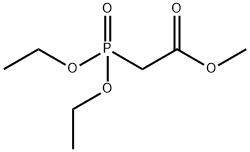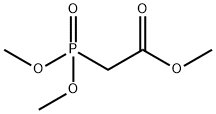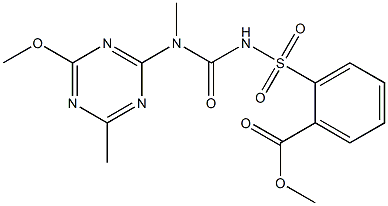Methyl diethylphosphonoacetate
Synonym(s):(Methoxycarbonylmethyl) diethoxyphosphine oxide;[(Methoxycarbonyl)methyl]phosphonic acid diethyl ester;Methyl P,P-diethylphosphonoacetate;NSC 147757
- CAS NO.:1067-74-9
- Empirical Formula: C7H15O5P
- Molecular Weight: 210.16
- MDL number: MFCD00009081
- EINECS: 213-938-2
- SAFETY DATA SHEET (SDS)
- Update Date: 2024-10-25 23:13:37

What is Methyl diethylphosphonoacetate?
Chemical properties
Clear colorless to slightly yellow liquid
The Uses of Methyl diethylphosphonoacetate
Methyl diethylphosphonoacetate is used as a reagent in the preparation of allylic fluorides compounds and in regioselective Diels-Alder reactions. It also serves as a reactant in the preparation of substituted thiophenes and furans, which finds application in type 2 diabetes treatment. Further, it acts as a precursor in the synthesis of pyridone alkaloids and immunosuppressive cyclopentanediol derivatives. In addition to this, it is utilized in the modification of botulinum neurotoxin serotype A protease inhibitors.
Properties of Methyl diethylphosphonoacetate
| Boiling point: | 127-131 °C9 mm Hg(lit.) |
| Density | 1.145 g/mL at 25 °C(lit.) |
| refractive index | n |
| Flash point: | >230 °F |
| storage temp. | Sealed in dry,Room Temperature |
| solubility | Miscible with tetrahydrofuran. |
| form | Liquid |
| color | Clear colorless to faint yellow |
| BRN | 1782397 |
| InChI | InChI=1S/C7H15O5P/c1-4-11-13(9,12-5-2)6-7(8)10-3/h4-6H2,1-3H3 |
| CAS DataBase Reference | 1067-74-9(CAS DataBase Reference) |
| NIST Chemistry Reference | Acetic acid, phosphono-, p,p-diethyl c-methyl ester(1067-74-9) |
Safety information for Methyl diethylphosphonoacetate
| Signal word | Warning |
| Pictogram(s) |
 Exclamation Mark Irritant GHS07 |
| GHS Hazard Statements |
H315:Skin corrosion/irritation H319:Serious eye damage/eye irritation |
| Precautionary Statement Codes |
P264:Wash hands thoroughly after handling. P264:Wash skin thouroughly after handling. P280:Wear protective gloves/protective clothing/eye protection/face protection. P302+P352:IF ON SKIN: wash with plenty of soap and water. P305+P351+P338:IF IN EYES: Rinse cautiously with water for several minutes. Remove contact lenses, if present and easy to do. Continuerinsing. P332+P313:IF SKIN irritation occurs: Get medical advice/attention. P337+P313:IF eye irritation persists: Get medical advice/attention. |
Computed Descriptors for Methyl diethylphosphonoacetate
| InChIKey | CTSAXXHOGZNKJR-UHFFFAOYSA-N |
| SMILES | C(OC)(=O)CP(OCC)(OCC)=O |
New Products
(S)-3-Aminobutanenitrile hydrochloride 4-Methylphenylacetic acid N-Boc-D-alaninol N-BOC-D/L-ALANINOL Tert-butyl bis(2-chloroethyl)carbamate 3-Morpholino-1-(4-nitrophenyl)-5,6-dihydropyridin- 2(1H)-one Furan-2,5-Dicarboxylic Acid Tropic acid S-2-CHLORO PROPIONIC ACID ETHYL ISOCYANOACETATE 2-Bromo-1,3-Bis(Dimethylamino)Trimethinium Hexafluorophosphate 4-IODO BENZOIC ACID 3-NITRO-2-METHYL ANILINE 1-(2,4-DICHLOROPHENYL) ETHANAMINE (2-Hydroxyphenyl)acetonitrile 4-Bromopyrazole 5,6-Dimethoxyindanone 2-(Cyanocyclohexyl)acetic acid 4-methoxy-3,5-dinitropyridine 1-(4-(aminomethyl)benzyl)urea hydrochloride 2-aminopropyl benzoate hydrochloride diethyl 2-(2-((tertbutoxycarbonyl)amino) ethyl)malonate tert-butyl 4- (ureidomethyl)benzylcarbamate Ethyl-2-chloro((4-methoxyphenyl)hydrazono)acetateRelated products of tetrahydrofuran








You may like
-
 1067-74-9 Methyl diethylphosphonoacetate 98%View Details
1067-74-9 Methyl diethylphosphonoacetate 98%View Details
1067-74-9 -
 Methyl Diethylphosphonoacetate CAS 1067-74-9View Details
Methyl Diethylphosphonoacetate CAS 1067-74-9View Details
1067-74-9 -
 Methyl diethylphosphonoacetate 96% CAS 1067-74-9View Details
Methyl diethylphosphonoacetate 96% CAS 1067-74-9View Details
1067-74-9 -
 Methyl diethylphosphonoacetate CAS 1067-74-9View Details
Methyl diethylphosphonoacetate CAS 1067-74-9View Details
1067-74-9 -
 1975-50-4 98%View Details
1975-50-4 98%View Details
1975-50-4 -
 2-HYDROXY BENZYL ALCOHOL 98%View Details
2-HYDROXY BENZYL ALCOHOL 98%View Details
90-01-7 -
 14714-50-2 (2-Hydroxyphenyl)acetonitrile 98+View Details
14714-50-2 (2-Hydroxyphenyl)acetonitrile 98+View Details
14714-50-2 -
 118753-70-1 98+View Details
118753-70-1 98+View Details
118753-70-1
Statement: All products displayed on this website are only used for non medical purposes such as industrial applications or scientific research, and cannot be used for clinical diagnosis or treatment of humans or animals. They are not medicinal or edible.